The two Persian Air Force Junkers W 33s were often fitted with a makeshift bombing installation, which enabled the 'bombardier' to roll the bombs down a wooden ramp and out through the cabin door. For course adjustments during the bombing run he would pull one of a pair of strings tied to the pilot's right and left arm! One of the assignments performed in December 1929 by German pilot Martin Hänichen was however a normal transport mission. It ended abruptly when he belly-landed the Junkers right after take-off at Shiraz. The aircraft was loaded to the brim with bombs, grenades, fuses and fuel cans! It was much over-loaded and Hänichen had been ordered to take off, despite his protests. To his own amazement he survived the incident. Adolf Böhme, who was engaged by the Persian Air Force as a W 33 mechanic, almost lost his life in another dramatic event a little later. He actually fell out of his aircraft when trying to fasten a hatch in the floor of the cabin. A sudden air pocket made him lift from his seat and to his horror he then fell through the hole where the hatch had now disappeared. He landed with his arms stretched out on the inside of the aircraft and the legs and lower part of his body pressed up against the underside of the fuselage by the slipstream! After struggling for what felt like an eternity and mobilizing the last of his strength, he finally managed to crawl back into the aircraft again!
These events may serve as an introduction to the diversified, interesting and little known history of aviation in Persia, or Iran, as the country has been known since 1935.
British, French and Russian Competition
In May 1920 Russian forces were landed on the Persian coast of the Caspian. They stayed until 1921 and during that year the British troops in the country were also withdrawn. A flight of RAF aircraft from Iraq that had been based at Bushehr (Bushire) since 1920 returned to Iraq in the autumn of 1921. Reza Khan, who had occupied Tehran and overthrown the previous government in February, immediately started to expel British influence from the country. In December 1925 he was to become His Imperial Majesty Reza Shah Pahlavi.
Already in the autumn of 1919 Persia had requested aircraft for its Gendarmerie from the RAF in Mesopotamia, but these discussions led to nothing. The first Persian military aircraft was a Russian machine, which had been abandoned at Rasht (Resht) in 1921 and had been carried away by Persian troops. Unfortunately the type of this aircraft is not known. It was taken to Tehran early in 1922 and was repaired by a Persian Armenian named Nikola, who had learnt to fly in America. He had certain spare parts made locally and finally managed to get the engine to function spasmodically. In August 1923 an attempt was made to taxi the machine, but this resulted in an accident which set fire to it and burnt off its wings.
In September 1921 the local newspapers at Tehran reported that the Persian Government had ordered 10 aircraft from the Swedish Government, 'which were to be flown to Persia via Russia by Swedish aviators'. This, however, soon turned out to be a canard. After a Soviet-registered Junkers F 13, R-RECA of Junkers-Luftverkehr, had visited Tehran in April 1923, the Government expressed a wish to acquire six such aircraft. The Junkers returned to Persia again in April 1924. In the meantime Great Britain was trying to challenge the traditional Persian dependence on Russian markets. The two powers were for a long time to compete with each other for political influence and goodwill in Persia. In July-August 1924 two RAF DH.9As visited Tehran and the local authorities were invited for demonstrations. Due to prevailing anti-British feelings no one came!
In the meantime Persia had made a more 'neutral' choice and ordered six aircraft from France. General Amanullah Mirza, Chief of Staff, had purchased two examples each of the Breguet 14 two-seat reconnaissance-bomber, and the Potez VIII and Spad 42 trainers. The French aircraft arrived at Bushehr on January 25, 1924, with pilots Berhault (chief of mission) and Gérard, and two mechanics, Banel and Sigann. After assembly the aircraft were to be flown to Tehran. In fact all but one crashed en route! One of the Breguets was flown by Berhault and arrived in Tehran on May 22, but the other aircraft were brought there by lorry. Five were repaired and received the following numbers and names: 1 Taghdir, 2 Oghab, 3 Shahin, 4 Homa and 5 Simorgh. The opening of a flying school was announced, but an appeal for voluntary students brought little response. Ten junior officers were instead selected for training in the USSR and sent to Moscow in August, where only six were accepted eventually. The Tehran school closed down in the autumn.
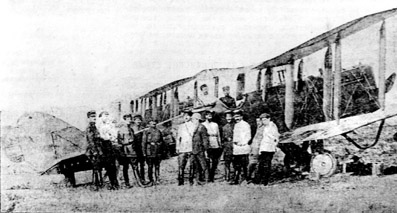 Starting in 1924, a total of nearly 30 Soviet-built R-1s were delivered to Iran. The R 1 was a copy of the de Havilland DH.9A powered by a Soviet-made 400 hp Liberty engine.
Starting in 1924, a total of nearly 30 Soviet-built R-1s were delivered to Iran. The R 1 was a copy of the de Havilland DH.9A powered by a Soviet-made 400 hp Liberty engine.
On May 12 two Russian R-1s (DH.9A copies, c/ns 2501 and 2503) arrived in Tehran, piloted by Vasil'chenko and Lozovsky. The aircraft were painted dark grey and had the Persian flag with the lion and sun emblem on the fuselage. Red-white-green cocades were painted on the lower surfaces of the wings. The aircraft had been handed over to the Persian Ministry of War already at Pahlavi (Enzeli) and were now inspected by Reza Khan and the Russian ambassador. The ambassador spoke about Persian-Soviet friendship and the crowds cheered. Reza took place in the cockpit of one of the aircraft and was told that the Russian planes had been flown on automobile petrol from Pahlavi, as no aviation fuel had been available there.
Several other Russian aircraft were en route via Baku and Pahlavi. Two Junkers F 13s (c/ns 675 and 676), which had been fitted with machine gun stands on the roof of the cabin in Moscow, arrived on May 21 and 22. They were flown by the Germans Wasserthal and Mossbacher. In June three more Russian aircraft were reported to have reached Tehran by motor lorry, two of them being "small dual-control machines for instruction". On July 7, a "Junkers dual-control machine" arrived. The last of the Russian aircraft was assembled at Pahlavi in September, but was damaged by heavy rains and was dismantled again and sent by lorry. It is difficult to establish exactly how many aircraft of each type the Russians sent. The total appears to have been seven, and seems to have been made up of two Junkers F 13s, two (or three) R-1s and two (or three) U-1 trainers. The U-1 was a Russian copy of the Avro 504K.
Another pair of R-1s arrived by road from Pahlavi in August and an "instructional Breguet", possibly a replacement for one of the damaged French aircraft, arrived at Bushehr on August 27. In May Junkers had offered to deliver its two-seat models A 20 and H 21 and on December 6, a Junkers "two-seater with machine gun mounting" arrived. This was almost certainly an example of the H 21 parasol reconnaissance aircraft, which had been brought "for the inspection of the War Office". Nothing more is known about this aircraft or if the Persians ever purchased it, but it was captured on a rare photograph taken in Tehran in the spring of 1925.
There were no strict rules for the application of the Persian national insignia. The aircraft normally carried red-white-green roundels on the fuselage and wings, and the rudder was painted in the same colours. Insignia were sometimes missing, however, on fuselage, upper wings, or rudder. A serial number in Persian numerals was painted under the wings.
On May 25, a flying display was held with all foreign representatives in Tehran invited. There was food and music and thousands of people went out to see the new Russian aircraft. On May 30, the Breguet 14 and an F 13 were sent to Borujerd, Luristan, to bomb insurgents, but the hope that this would have some moral effect was allegedly not justified. The Junkers was replaced by an R-1 on July 2. A consignment of 400 Krupp-made bombs arrived from Germany in October and these were later used against the insurgents. Walter Wassertal took off in F 13 c/n 675 from Tehran on November 9 with his mechanic Riskowsky and a Persian officer on board. They flew to Bushehr and returned to Tehran after one month. The other F 13 and the Breguet were based at Bunder Dilam, Arabistan, to participate in operations starting on November 24. Berhault disappeared on December 17, while en route to Tehran in the Breguet. He had force landed and turned up at Esfahan (Isfahan) nearly three weeks later after having walked there on foot.
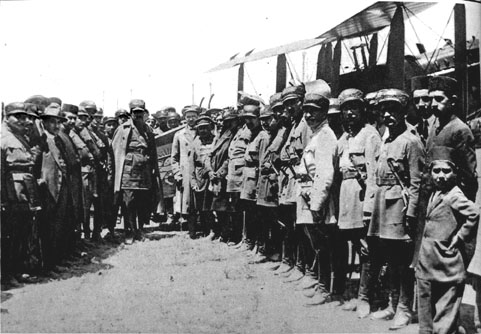 The Persian national markings consisted of the flag with the lion and sun emblem on the fuselage, as can be seen on this R-1, red-white-green roundels on the wings and on the horizontal tail surfaces, and the flag on the rudder.
More Junkers Aircraft
The Persian national markings consisted of the flag with the lion and sun emblem on the fuselage, as can be seen on this R-1, red-white-green roundels on the wings and on the horizontal tail surfaces, and the flag on the rudder.
More Junkers Aircraft
Famous Swiss pilot Walter Mittelholzer took off from Zürich on December 18, 1924, to fly to Persia. His aircraft was a Junkers A 20 floatplane registered CH130 (c/n 463) and named Switzerland. He was forced to remain for a month in Turkey due to diplomatic problems but continued after the floats had been replaced by wheels and arrived in Tehran on January 27, 1925. The purpose of the flight was to demonstrate the aircraft to the Persian authorities. This proved successful and the aircraft was sold after a new engine had been fitted in March. In May Junkers sent new offers for the A 20 and H 21 and received an order for a second A 20. C/n 881 flew from Berlin via Moscow and reached Pahlavi in November. An F 13 floatplane (c/n 614, ex Junkers-Luftverkehr R-RECE) was purchased by the War Office for the Persian Northern Independent Brigade in July and was delivered in the autumn.
In December 1925 the aircraft inventory Persian Air Force was reported to consist of two R-1s, three U-1s, two Junkers F 13s, one Junkers A 20, two Potez VIIIs, one Spad 42, one Breguet 14A2, all based in Tehran, and another Breguet awaiting spares at Bandar Gez. The Junkers F 13 floatplane, purchased specially to patrol the Caspian for the prevention of smuggling and Turkoman raids from the sea, and one A 20 were at Pahlavi. A crashed Spad 42 was lying in South Persia and a Breguet 19 purchased recently in Paris had crashed at Constantinople. There were one French, two German and two Russian pilots, and seven French, German and Russian mechanics. In February Russian pilot Vasil'chenko had started pilot training with three Persian officers. Four aircraft hangars had been erected at Tabriz, Hamadan, Shiraz, Mashad (Meshed) and Pahlavi.
In August 1925 Reza Khan had asked the Russians to supply three aircraft in order to make it possible for three of the Persian officers training at the Moscow Aviation School to return home in their own aircraft. Although the Russians saw the propaganda prospects of this they had doubts about the risks of sending out the inexperienced Persian pilots. On December 16, the Persian Ministry of War ordered three R-2s (Soviet-built copies of the DH 9) with armament and spare parts. The Persian pilots took off in January 1926 to fly them from Baku to Tehran. One met with an accident not far from Baku and had to be left at the site of the crash. Two reached Kazvin, but could not take off again due to the sodden state of the aerodrome. Both arrived in Tehran in March - one by air, the other by lorry.
An officer named Ahmed Khan Nakhchevan had been sent to France in 1922 to learn to fly. He remained there until 1925. He was to fly from Paris to Tehran in a Breguet 19 that had been purchased for the purpose. He left Paris in October but crashed his plane not far from Constantinople. He finally reached Tehran on February 24, 1926, with a new Breguet 19. The damaged aircraft was dismantled and brought to Persia, but probably never flew again. Colonel Nakhchevan was appointed Chief of the Persian Air Force and tried to impose some discipline on the mixed French, German and Russian personnel. The local flying school closed again in June. Training had been desultory and irregular for two years and none of the seven students had soloed. At the same time Berhault left for home. Discussions were under way with Junkers over the establishment of a new flying school, but in the meantime five officers were sent for training in France.
On May 1, 1926, the Air Force gave a display with three Junkers, the Breguet 19, a Spad, a Potez, 2 U-1s and 3 R-1s as part of the Shahs coronation festivities. Some stunt flying was done in one of the Junkers A 20s. On May 6, four Turkish Junkers A 20s visited Tehran and on July 24, a Russian R-1 registered R-ROST and named 'Iskra' arrived from Moscow.
In the autumn of 1926 aircraft were sent out to several regions to fight local rebellions. One aircraft piloted by a Russian crew crashed near Kermanshah in September while performing reconnaissance over Kurdistan and was written off. Another came down at Kazvin, but was later brought to Tehran by lorry. By November only two aircraft were serviceable. The German pilots had quit and just two Russians and two Persians remained. There were also two Russian, one German and one French mechanic.
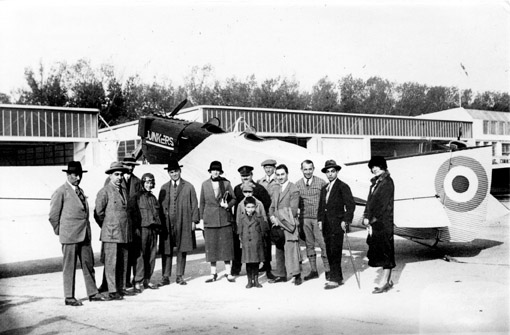 This Junkers A 20 two-seater was the second aircraft of that type in Iran. It is photographed here in Germany before the delivery flight to Tehran in the autumn of 1925. (Günther Ott)
This Junkers A 20 two-seater was the second aircraft of that type in Iran. It is photographed here in Germany before the delivery flight to Tehran in the autumn of 1925. (Günther Ott)
In order to put political pressure on the regime, the Soviet Union placed an embargo on Persian goods in 1926 with disastrous results for Persian agricultural interests. In the following year an ad hoc trade agreement was signed. At the same time (October 1, 1927) a non-aggression and neutrality treaty was concluded after protracted negotiations. In the meantime Russian aircraft had continued to arrive. Three new R-1s were acquired in the summer of 1927 and spare parts for the unserviceable Junkers, Breguet and Spad types were also obtained. Junkers sent out a K 53 two-seater for demonstrations. This was an armed version of the A 20/A 35. While doing stunt flying on September 30, Junkers pilot Peter Wagner crashed in front of several thousands of spectators after the aircraft had broken up in mid-air. The incident immediately reduced Persian interest in an offer for 30 Junkers A 40s, which was an improved version of the A 35/K 53.
In March 1928 new hangars for the Tehran airport were ordered from France and bombs were purchased from the USSR. The Soviet Government promised to pay for the training of five Persians in Moscow. Naib II Baqir Khan, one of the officers sent there in April, received instructions in the following month to order five new R-1s. These aircraft were sent by boat to Pahlavi and arrived on June 19 with a number of Russian crew. A total of three R-1s crashed at Pahlavi after assembly, however, but one of these was repairable. A second shipment consisting of five new U-1 trainers was assembled at Tehran in August. The arrival of new aircraft immediately increased flying activity and great plans were drawn up for an expansion of the Air Force.
Further Deliveries from Germany and the USSR
In May 1929 the Persian Government asked if three DH.9As could be obtained from the RAF in Baghdad, but did in the event not accept the second-hand aircraft that were offered. In France Potez designed the Potez 25.59 version of its successful two-seat reconnaissance bomber for Persia. No order was ever placed and instead Junkers won the game. Since early 1928 they had tried to sell the W 33 transport to Persia. An ambulance version was first suggested and later a W 33 was offered to the Ministry of Finance for customs duties along the coast of the Persian Gulf. In February 1929 Junkers offered a complete air force, consisting of the W 33 fitted out as a bomber and the K 45 (improved K 53/A 35) light bombing and observation two-seater. Initial equipment would be 32 K 45s, 24 W 33s and 10 primary and five advanced trainers. Each squadron was to consist of one flight of K 45s and one of W 33s. Squadrons were to be based at Tehran, Shiraz, Mashad, Rasht and Tabriz. An aircraft park with a workshop was to be located at Tehran and a flying school at Kazvin. Nakhchevan, who was French-oriented, was more interested in the French Potez 25 offer, but the Shah would not have this, as he had always considered the purchase of French aircraft in 1924 a failure.
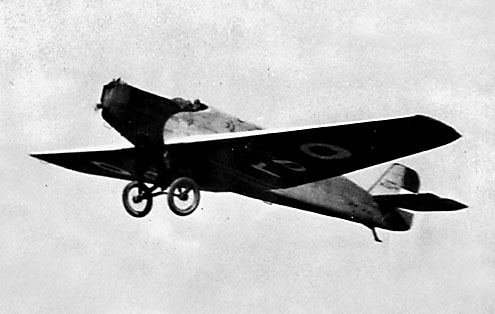 Junkers W 33 with serial number 'J7'.
Junkers W 33 with serial number 'J7'.
Two W 33s (c/ns 2546 and 2549) were ordered in June for immediate delivery by air. They were flown by Martin Hänichen and Erich Haal, who were accompanied by two mechanics and a Persian student who had been practising at the Junkers factory. The new aircraft arrived in Tehran already in July, were handed over by the local Junkers representative and inspected by the Shah. The German crews had expected to be employed for transport work but their duties now turned out to be bombing and reconnaissance. The W 33s were immediately pressed into action against rebels fighting the regular Persian Army. Haal's aircraft, J7, was based at Qila Murgha (Galeh Morgi, 5-6 km outside Tehran), while Hänichen's J8 was sent to Esfahan.
Immediately after landing at Esfahan Hänichen was ordered to reconnoitre the Bachtiaren front. The second mission on the first day was to bomb the rebels in the Sefid Dasht area and to drop food supplies to a surrounded army unit. A number of bombs were dropped at Deh I Kurd, and after refuelling, bread packs were 'delivered' at Sefid Dasht. The Junkers was hit several times by ground fire. The Air Force was not entirely popular among the troops, as they often had experienced being bombed by their own aircraft. A week of reconnaissance and supply flights followed. Infantry attacks were supported by bombing and after a couple of weeks the rebels surrendered and the aircraft returned to Tehran. In September both Junkers aircraft flew missions around Lar. The R-1s seem to have been fairly inactive during these operations.
Two of the old F 13s (c/ns 614 and 676) were repaired and modified in the autumn of 1929. The first was wrecked at Qila Murgha on November 12, however, when Nakhchevan attempted to take off with the fuel cocks closed. A total of 12 R-1s were delivered from the USSR in 1929-30. On September 24, 1929, the first six took off from Baku, but one met with an accident on the way to Pahlavi and another was lost between Pahlavi and Tehran. In January 1930 one of the Persian R-1s collided with a radio mast at Bushehr and was destroyed. The Persians had now become interested in the more modern Tupolev I-4 fighter and the Tupolev R-3 reconnaissance aircraft. Iza Khan, a Persian officer, visited Moscow and was allowed to test-fly the R-3, which was also offered to Persia. In the end it was decided to stick to the R-1, however, and six more were ordered. This batch was sent by boat in crates and arrived at Pahlavi on June 22.
The Government now proposed to hold an aircraft competition at the end of August in order to select the most suitable aircraft for the planned future expansion of the Persian Air Force. In September three Russian Polikarpov R-5 two-seat reconnaissance aircraft visited Tehran. They returned for the exhibition held in October-November and a French Potez also arrived. On October 12, another foreign aircraft landed at Mashad. It was a Soviet aircraft flown by a pilot who had decided to defect from the USSR with his wife.
In October 1930 Nakhchevan was suspended and replaced by Major Khosrovani as commandant of the Air Force. Nakhchevan later returned to office but was again suspended in July 1931. This time Brigadier Saler Nizam Koupal took charge of the Air Force together with Major Khosrovani. Nakhchevan was reinstated and appointed Inspector General of Aviation in September 1932. At the same time Khosrovani took up his former office as Commandant of the Air Force. The Air Force was not independent, but a part of the Army. Its title was in French, l'Aeronautique Persane, l'Armée Imperiale Persane, but later it became known in English as the Imperial Iranian Air Fore.
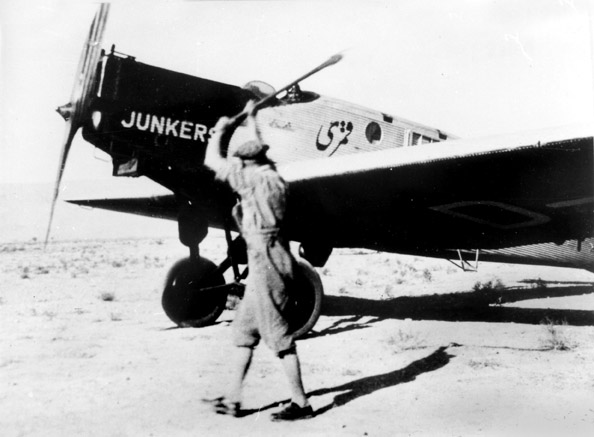 Junkers W 33 D-1684 Gomri of Junkers-Luftverkehr. One can only ponder over what the man with the stick is doing! (Volker Koos)
German Airline
Junkers W 33 D-1684 Gomri of Junkers-Luftverkehr. One can only ponder over what the man with the stick is doing! (Volker Koos)
German Airline
Early in 1924 the German Junkers-Luftverkehr company contacted the Persian Government regarding its planned Stockholm-Moscow-Tehran air service. The Junkers representative Jaroljmek was granted an audience with Reza Khan already two days after his arrival in Tehran in June 1924. He was told that the Shah was not interested to give neither the British nor the Russians any airline concessions. In September Reza Khan accepted the Junkers conditions and made promises for a subvention. On October 1, an air traffic concession was granted for the Baku-Pahlavi-Tehran route. Five of the Moscow-based Junkers-Luftverkehr F 13s were transferred to the new airline in November-December 1924. A flight with mail was made on December 13, and seven days later the route was officially opened. It was, however, operated regularly just for a few months and the subvention promises were not fulfilled.
Imperial Airways wanted to open an air service between Cairo and Karachi along the Persian coast and in October-November 1925 an aircraft from the French CINA company visited Tehran. To counter the competition Junkers sent a three-engined Junkers G 24 for demonstrations in December and in the spring of 1926 a second aircraft of the same type arrived. Their effort paid off and in February 1926 Junkers reached a new agreement. The signing of the final contract was delayed until January 1927, when the Ministry of Post and Telegraphs granted Junkers a five-year concession on airmail services.
The Tehran-Pahlavi service was reopened on February 11, 1927. The Ukrainian company Ukrvozdukhput' took over at Pahlavi and flew the mail to Moscow. A Tehran-Hamadan-Kermanshah service was opened in the following month and a Teher-Mashad route was added in December. In June Ettel had replaced Jaroljmek as manager of Junkers-Luftverkehr and Weil became the company's technical manager. Achilles, Bauerhin, Günther, Jüterbock, Morzik, Mosbacher, Schäfer, Stams and Wangenheim were among the German pilots serving in Persia, and there were also two Russians, Tumansky and Kudryavtsev. In order to get landing rights at Baku the company had to have one Russian pilot employed at all times. The pilots generally found flying conditions in Persia difficult, with dust storms and haze on the plains and storm clouds and low visibility in the winter and spring.
In April and June 1927 two new Junkers F 13s (c/ns 800 and 2001) arrived from Germany and in August the first W 33 (c/n 794) was added to the company's fleet. The Government had requested help against an epidemic in the south of the country and anti-cholera serum and injection syringes were sent with the W 33 and a Junkers G 31 that arrived on September 19. Physicians and serum were transported out to different locations in South Persia by Junkers pilot Harder. The three-engined G 31 had been sent for demonstrations, but crashed after a few days with 20 passengers on board. No one was injured, however. The aircraft was repaired and sent back to Germany in May-June 1928. Junkers had initially been using the military aerodrome at Qila Murgha, but in August 1927 the company's new premises outside Tehran with airport and well-equipped workshops were inaugurated.
A new route, Tehran-Esfahan-Shiraz-Bushehr, was added to the Junkers network in April 1928. In the summer a camera was installed in the W 33 and a photographic survey was made of the trail of a planned railroad from Bender Guez to Tehran and further to Hamadan. New W 33s were acquired; Bolbol (c/n 2505) in November 1928, and Tuti, Ogab and Gomri (c/ns 2526, 2535 and 2577) in March, May and December 1929. One of the F 13s was returned to Germany and on September 15, the Anglo-Persian Oil Company (APOC) charted another F 13, including pilot (Wangenheim), to be used principally for the transport of opium. It was to be stationed at Abadan for one year. In April 1929 the Kermanshah service was extended to Baghdad and in May Tehran-Mashad was reopened.
Junkers-Luftverkehr. Statistics for the first three years
|
|
1927
|
1928
|
1929
|
|
Number
of flights
|
1047
|
1476
|
1877
|
|
Flown
km
|
193,039
|
337,494
|
549,689
|
|
Passengers
|
2,812
|
4,033
|
3,768
|
|
Mail
(kg)
|
756
|
4,930
|
21,537
|
|
Freight
and luggage (kg)
|
37,602
|
87,992
|
213,201
|
Junkers was commissioned in September 1930 to transport the precious exhibits for the 'Exhibition of Persian Art' in London from Tehran to Abadan. In the following year negotiations started about the terms of a renewed contract, but there were difficulties. In 1929 Junkers had delivered a proposition for a new military flying school equipped with Junkers T 26 or A 50 trainers. According to the February 1927 contract Junkers was obliged to train two pilots per year and to start a school. This had never been realised and the flying school discussions dragged on into 1931. The Persians interpreted the terms of the contract to mean that Junkers would be running the school, but Junkers only wanted to provide its installation.
In October 1931 Junkers began to close down and reduced services. The contract expired on January 31, 1932, and the last service between Tehran and Baghdad was planned for February 5. As there was still some hope of a new agreement, flying continued, but on March 27 the service was definitely closed down. The F 13 chartered by APOC would remain until the end of the year. A British diplomat reported: "My predecessors have frequently expressed their admiration of the efficiency and reliability of the Junkers' service...". "I think I may say that this admiration is shared by every European in Persia and by many Persians, and that regret at their departure is universal. Junkers have maintained to the end their record of having never injured a passenger or lost a bale of goods".
The aircraft were to remain idle on the aerodrome for a long time but were eventually returned to Germany in September 1933. The oldest W 33 was taken over by the German pilot Zitzmann and used by him for several years.
Aircraft used by Junkers-Luftverkehr in Persia
|
C/n
|
Registration
|
|
In service
|
|
Notes
|
|
|
Russian
|
German
|
From
|
To
|
|
|
Junkers F 13
|
|
569
|
RRECK
|
--
|
12.24
|
.27
|
Ex-Jlag Moscow. Sold in Germany, to D-1183.
|
|
614
|
RRECE
|
--
|
11.24
|
7.25
|
Ex-Jlag Moscow. Sold to Persian A/F
|
|
643
|
RRECC
|
D-231
|
11.24
|
.33
|
Ex-Jlag Moscow. Stored 12.32. Cx 9.33
|
|
651
|
RRECI
|
D-265
|
11.24
|
2.29
|
Ex-Jlag Moscow. To Junkers. Sold in Germany.
|
|
693
|
RRECG
|
D-1304
|
12.24
|
.33
|
Ex-Jlag Moscow. Stored 12.32. Cx 9.33.
|
|
800
|
--
|
D-1071
|
4.27
|
7.28
|
To Junkers, sold as C-RBIM.
|
|
2001
|
--
|
D-1126
|
6.27
|
9.33
|
To Junkers, sold to DVS.
|
|
|
|
|
|
|
|
|
Junkers W 33
|
|
794
|
--
|
D-921
|
8.27
|
.33
|
Stored
12.33. Sold to Fr Zitzmann 1934, seized by
Government 1939
|
|
2505
|
--
|
D-1197
|
12.28
|
8.33
|
Bolbol. To Junkers, sold to DVS
|
|
2526
|
|
D-1590
|
5.29
|
9.33
|
Tuti. To Junkers, sold to DVS
|
|
2535
|
|
D-1630
|
6.29
|
7.33
|
Ogab . To Junkers, sold to DVS
|
|
2577
|
|
D-1684
|
12.29
|
9.33
|
Gomri. To Junkers, sold to DVS
|
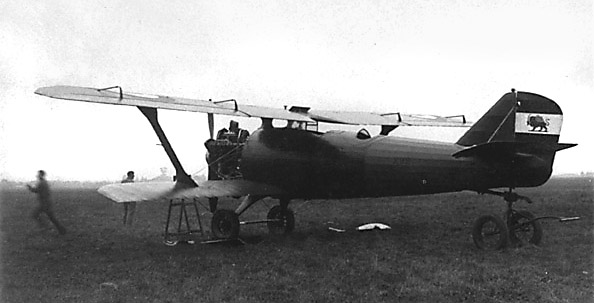 A Breguet 19, probably before delivery. A small serial number (292) is painted on the fuselage and the Persian lion and sun emblem and national colours are on the rudder. (Matthieu Comas)
Building a New Air Force
A Breguet 19, probably before delivery. A small serial number (292) is painted on the fuselage and the Persian lion and sun emblem and national colours are on the rudder. (Matthieu Comas)
Building a New Air Force
In January 1932 the Swedish Captain Elis Nordquist was engaged as adviser to the Persian Air Force and at the same time a Swedish mechanic was contracted. Nordquist was entrusted with the acquisition of new aircraft and expansion of the Air Force. In May Avro 626 trainer G-ABRK arrived for demonstrations, but this type did not find approval. Nordquist was sent to Great Britain in June, accompanied by the Persian pilot Issa Khan. Major Arfa, who was purchasing war material in Europe, later joined them. An order was signed for 20 de Havilland DH 82 Tiger Moths (c/ns 3117-3136), intended for a new military aviation school, which was to be established at a new aerodrome constructed outside Tehran.
In December 1932 the new trainers started to arrive at Ahvaz (Ahwaz). Company pilot Hugh Buckingham, who brought with him a Fox Moth for his personal use, assembled them. One got into a spin, crashed and was burned while being transferred to Tehran by a Persian pilot, but the remaining 19 were initially based at Qila Murgha until the school could get started. Erik Ekman, another Swede, was engaged as flying instructor and arrived in January 1933. On February 22, 18 Tiger Moths were flown during a review of troops, but on March 7, two of the trainers collided in mid-air and were destroyed completely. The first fourteen Persian pilots were trained in 1933 and received their wings in the summer of the following year.
At the end of 1932 ten Polikarpov R-5 reconnaissance bombers were ordered in Moscow. The Persian pilot Makovi flew the first one from Moscow to Tehran on May 28, 1933, and the rest were shipped to Pahlavi in June. The R-5's performance was found to be below expectations and the type was soon relegated to advanced training. The R-5 order was the last one placed in the Soviet Union.
Nordquist left for Britain again in May 1933. Another nine Tiger Moths (c/ns 3200-3208) and three extra float undercarriages were ordered, and in September a further 14 aircraft were added. The second order was later reduced to ten (c/ns 3228-3237), however. Whereas the first 20 Tiger Moths had Gipsy III engines all further examples were fitted with the more powerful Gipsy Major. A contract was also signed for the supply and erection in Persia of an aeroplane factory for de Havilland and Hawker aircraft and a Swedish engineer was engaged to supervise this work. Persian technicians and mechanics were sent to Sweden to study the Swedish Air Force.
The nine Tiger Moths were landed at Ahvaz in December 1933 and were assembled in a new Boulton Paul hangar erected there. The second batch of ten aircraft was delivered in September 1934. Five new Swedish flying instructors arrived in January 1934, but during the summer some of the Swedish officers were suddenly dismissed. The Swedes were dissatisfied with the way they were treated and in the event all decided to leave prematurely. A Belgian Air Force officer, Colonel Bevir, arrived to take Nordquist's place as air adviser and a Major and six flying instructors from Belgium were engaged at the end of the year. Bevir was to stay until May 1938, but the other Belgians left for home in August 1936.
In January and March 1933 a total of 14 Hawker Audax two-seat reconnaissance bombers and 16 Hawker Fury single-seat fighters were ordered for the Persian Air Force. Both types were to be fitted with Pratt & Whitney Hornet S2B1-G engines. After tests in the summer and autumn of 1933 at Brooklands, several problems were reported with the installation of the American engine. A decision, which was probably influenced by political pressure, was finally taken in November to use British engines instead of American ones for the fighters and for any further Audax orders. A second contract brought the total number of Furies to 28, but in the event only 24 were to be delivered, the last four of the first order being substituted for the same number of Audaxes. The 18 (14+4) Audaxes were delivered with Hornet engines and arrived in January 1934 for assembly and testing by Hawker pilot Philip G Lucas. One of the Junkers W 33s was used to transport Persian personnel to Ahvaz to collect the new aircraft, which were allocated to the 1st Regiment at Qila Murgha.
The Furies had their Hornet engines replaced by Bristol Mercury IV.S2 units before delivery, s/n 203 flying for the first time with the new engine in September 1934. They arrived in Persia during the period November 1934 to January 1935. Twelve Audaxes fitted with the Hornet engines taken from the first batch of Furies were delivered in March 1935 and the last of 26 similar aircraft powered by the Bristol Pegasus IIM and IIM2 were shipped in April 1935. At that time the Persian Air Force had been completely re-equipped with a total of 80 Hawker aircraft.
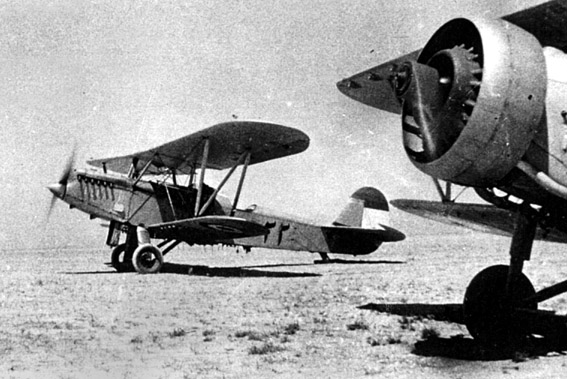 Ten Polikarpov R-5 reconnaissance aircraft were acquired from the Soviet Union in 1933, but this type was not very popular in Iran. Aircraft no 33 preparing to take off.
Ten Polikarpov R-5 reconnaissance aircraft were acquired from the Soviet Union in 1933, but this type was not very popular in Iran. Aircraft no 33 preparing to take off.
In June 1934 the Shah and a mission of Iranian officials visiting Turkey saw an aerial display with a Turkish-built Curtiss Fledgling two-seat trainer, which had been presented as a gift to the Shah. Later in the same month a Turkish Air Force officer flew the Curtiss to Tehran, and in October a flight of five Persian Audaxes were sent to Ankara to be present at the Turkish independence anniversary.
Continued in Part 2.




